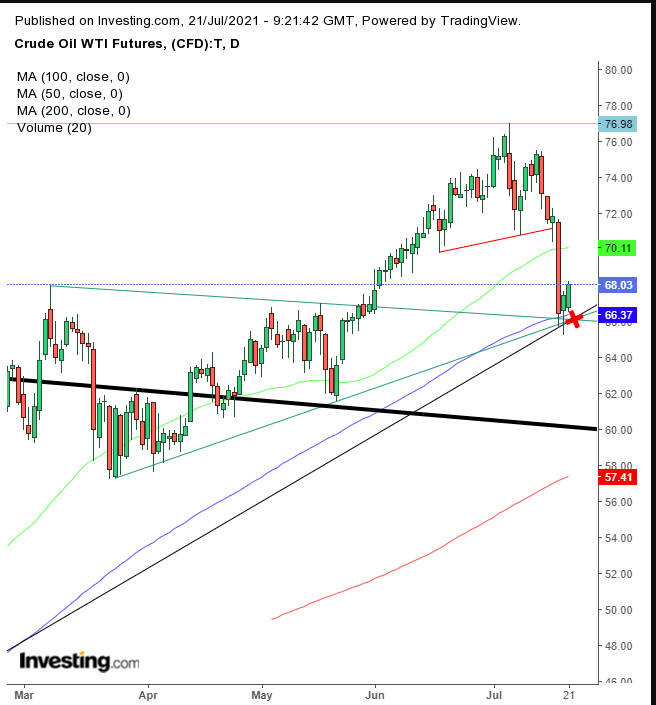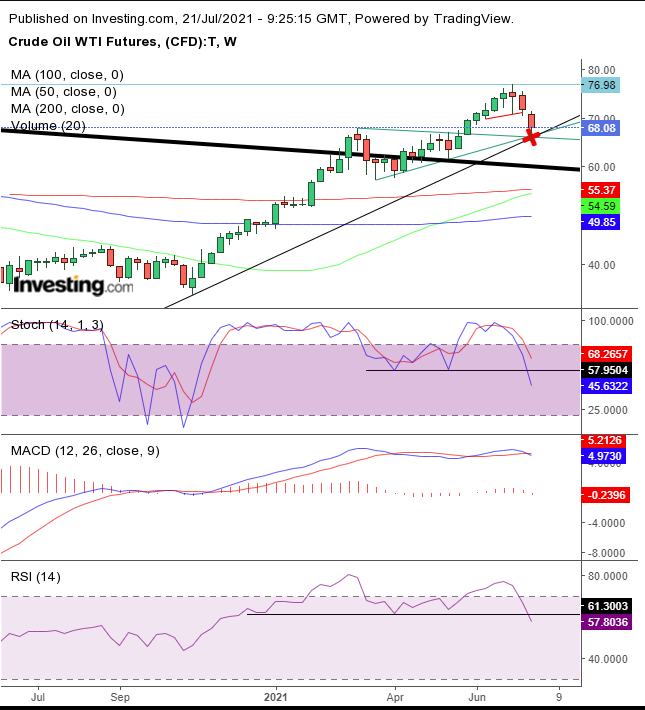During trading on Wednesday, gains in crude oil were scaled back, after Tuesday’s rebound. This followed an unexpected build in US inventories, underscoring concerns for reduced demand as the spread of the Delta strain of COVID-19 accelerates globally.
Yesterday's API data saw US stocks swell by 806,000 barrels for the week through July 16, bringing the total in storage to totalling just under 50 million barrels.
The surprise build follows a week in which there was a drawdown in inventories of more than 4 million barrels, in line with estimates. The negative print exacerbated a selloff in crude, as investors priced in the recent OPEC+ breakthrough agreement to increase output from pandemic levels, as a way of meeting the anticipated sharp increase in demand as the global economy reopens.
Is this shift in trend—from a drawdown to an unforeseen build, in the same week, at the same time that US equities suffered their first weekly drop in a month—a speed pump or something more ominous: escalating concerns that the rampant pandemic will disrupt what till now was expected to be a vigorous economic recovery.
Hard to know at this stage, but analysts at Goldman Sachs, for one, are maintiaining their bullish outlook on the commodity and don't see a reason to change their position at this juncture.
Even after OPEC’s output increase, the market remains tight according to current demand projections—which would of course change, if social restrictions persist. Right now, Goldman is forecasting that the virus’s impact on demand will be in the region of 1 million barrels a day, and then only for a few months, less so if vaccines prove effective in limiting the number of hospitalizations in developed markets, where demand potential is highest this summer.
The technicals confirm Goldman’s accelerating oil price trajectory.

Although WTI gave up earlier gains today, nearly erasing yesterday’s rally, we're impressed the price remains at current levels for the second day.
Following yesterday’s long, lower shadow, as bulls drove back a bearish attack, the price found support precisely on the apex of a bullish triangle, also happened to be tied in with the uptrend line since the October low, reinforced by the 100 DMA. This confluence, marked by the red X, is presumably the bullish stronghold that's expected to provide sufficient demand to absorb the current supply, then take on the July 6, $77 high, returning the price to its highest since 2014.
Such lofty sights are appropriate after bulls captured the downtrend line since the 2008 all-time high.
Notice the moving average interplay. The 50 DMA, representing the short-term, points at the technical pressure point below the recent, small H&S top. The 100 DMA, referring to the medium term, joined with the uptrend line since the October low, pointing to the triangle’s apex.
Finally, the 200 DMA is rising fast toward the thick black line, the downtrend since the July 2008, from the $147 all-time high.
However, it won’t necessarily be smooth sailing. The weekly chart, below, provides bearish indications, suggesting rough seas ahead.

Stochastics, the MACD and the RSI all topped out, as the 50-week MA slows below the 200-week MA. If the shorter moving average finds resistance by the longer one, it will signal prices are slowing, a bearish indicator. Therefore, consider all the risks before entertaining a trade—then prepare a plan to justify it.
Trading Strategies
Conservative traders would stay out of this one, until the price makes a new high and undoes the pessimistic weekly indicators.
Moderate traders could risk a long position if the price is just right, i.e. returning toward yesterday’s lows, limiting exposure.
Aggressive traders should buy the contract, provided they understand and accept the risks described, draw a plan accordingly, and are willing to lose their capital. Money management is important, especially now. Here’s an example:
Trade Sample
- Entry: $68
- Stop-Loss: $65
- Risk: $3
- Target: $77
- Reward: $9
- Risk:Reward Ratio: 1:3
Author's Note: These are just samples and not necessarily the only approach to these trades. Also, they're not the full analysis. If you didn’t read, understand and accept the risks described in the post, do NOT trade. The above analysis is merely our interpretation of the market dynamics and of the principles of technical analysis. We could be wrong. Even if our interpretations are sound, they only establish a statistical forecast. They are not a crystal ball. The objective of trading is to achieve success on a statistical basis, not an individual one. Trading is nothing more than luck management, as the trader attempts to get on the side of statistics. Before you enter a trade, realize you could lose the capital you committed. If you can’t handle that loss, do NOT enter a trade. You need to develop your own trading style, which suits your budget, temperament and timing. Your trading plans must reflect that. Until you learn how to do that, follow our samples if you wish, for education, though not profit...or you will end up with neither. Guaranteed. And no money back.
Which stock should you buy in your very next trade?
With valuations skyrocketing in 2024, many investors are uneasy putting more money into stocks. Unsure where to invest next? Get access to our proven portfolios and discover high-potential opportunities.
In 2024 alone, ProPicks AI identified 2 stocks that surged over 150%, 4 additional stocks that leaped over 30%, and 3 more that climbed over 25%. That's an impressive track record.
With portfolios tailored for Dow stocks, S&P stocks, Tech stocks, and Mid Cap stocks, you can explore various wealth-building strategies.
